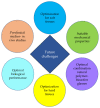A Review of Bioactive Glass/Natural Polymer Composites: State of the Art
- PMID: 33291305
- PMCID: PMC7730917
- DOI: 10.3390/ma13235560
A Review of Bioactive Glass/Natural Polymer Composites: State of the Art
Abstract
Collagen, gelatin, silk fibroin, hyaluronic acid, chitosan, alginate, and cellulose are biocompatible and non-cytotoxic, being attractive natural polymers for medical devices for both soft and hard tissues. However, such natural polymers have low bioactivity and poor mechanical properties, which limit their applications. To tackle these drawbacks, collagen, gelatin, silk fibroin, hyaluronic acid, chitosan, alginate, and cellulose can be combined with bioactive glass (BG) nanoparticles and microparticles to produce composites. The incorporation of BGs improves the mechanical properties of the final system as well as its bioactivity and regenerative potential. Indeed, several studies have demonstrated that polymer/BG composites may improve angiogenesis, neo-vascularization, cells adhesion, and proliferation. This review presents the state of the art and future perspectives of collagen, gelatin, silk fibroin, hyaluronic acid, chitosan, alginate, and cellulose matrices combined with BG particles to develop composites such as scaffolds, injectable fillers, membranes, hydrogels, and coatings. Emphasis is devoted to the biological potentialities of these hybrid systems, which look rather promising toward a wide spectrum of applications.
Keywords: bioactive glasses; biological performance; composites; mechanical properties; natural polymers.
Conflict of interest statement
The authors declare no conflict of interest.
Figures
Similar articles
-
Biomedical applications of chitosan/silk fibroin composites: A review.Int J Biol Macromol. 2023 Jun 15;240:124407. doi: 10.1016/j.ijbiomac.2023.124407. Epub 2023 Apr 13. Int J Biol Macromol. 2023. PMID: 37060984 Review.
-
Bioactive Silk Fibroin-Based Hybrid Biomaterials for Musculoskeletal Engineering: Recent Progress and Perspectives.ACS Appl Bio Mater. 2021 Sep 20;4(9):6630-6646. doi: 10.1021/acsabm.1c00654. Epub 2021 Aug 9. ACS Appl Bio Mater. 2021. PMID: 35006966
-
Incorporation of Cu-Containing Bioactive Glass Nanoparticles in Gelatin-Coated Scaffolds Enhances Bioactivity and Osteogenic Activity.ACS Biomater Sci Eng. 2018 May 14;4(5):1546-1557. doi: 10.1021/acsbiomaterials.8b00051. Epub 2018 May 1. ACS Biomater Sci Eng. 2018. PMID: 33445312
-
Thermally triggered injectable chitosan/silk fibroin/bioactive glass nanoparticle hydrogels for in-situ bone formation in rat calvarial bone defects.Acta Biomater. 2019 Jun;91:60-71. doi: 10.1016/j.actbio.2019.04.023. Epub 2019 Apr 13. Acta Biomater. 2019. PMID: 30986530
-
Gelatin and Bioactive Glass Composites for Tissue Engineering: A Review.J Funct Biomater. 2022 Dec 31;14(1):23. doi: 10.3390/jfb14010023. J Funct Biomater. 2022. PMID: 36662070 Free PMC article. Review.
Cited by
-
Resorbable Membranes for Guided Bone Regeneration: Critical Features, Potentials, and Limitations.ACS Mater Au. 2023 Jun 23;3(5):394-417. doi: 10.1021/acsmaterialsau.3c00013. eCollection 2023 Sep 13. ACS Mater Au. 2023. PMID: 38089090 Free PMC article. Review.
-
Recent Advancements in Materials and Coatings for Biomedical Implants.Gels. 2022 May 21;8(5):323. doi: 10.3390/gels8050323. Gels. 2022. PMID: 35621621 Free PMC article. Review.
-
Therapeutic functions of medical implants from various material categories with integrated biomacromolecular systems.Front Bioeng Biotechnol. 2025 Jan 10;12:1509397. doi: 10.3389/fbioe.2024.1509397. eCollection 2024. Front Bioeng Biotechnol. 2025. PMID: 39867472 Free PMC article. Review.
-
Mesoporous Silica-Bioglass Composite Pellets as Bone Drug Delivery System with Mineralization Potential.Int J Mol Sci. 2021 Apr 29;22(9):4708. doi: 10.3390/ijms22094708. Int J Mol Sci. 2021. PMID: 33946793 Free PMC article.
-
Multifunctional bioactive glass nanoparticles: surface-interface decoration and biomedical applications.Regen Biomater. 2024 Sep 6;11:rbae110. doi: 10.1093/rb/rbae110. eCollection 2024. Regen Biomater. 2024. PMID: 39323748 Free PMC article. Review.
References
-
- Linden M., Ray D. Life expectancy effects of public and private health expenditures in OECD countries 1970–2012: Panel time series approach. Econ. Anal. Policy. 2017;56:101–113. doi: 10.1016/j.eap.2017.06.005. - DOI
-
- Daware M.A. Review Article Osteoporosis in Elderly. Vidarbha. J. Intern. Med. 2014;17:19–27.
Publication types
LinkOut - more resources
Full Text Sources



